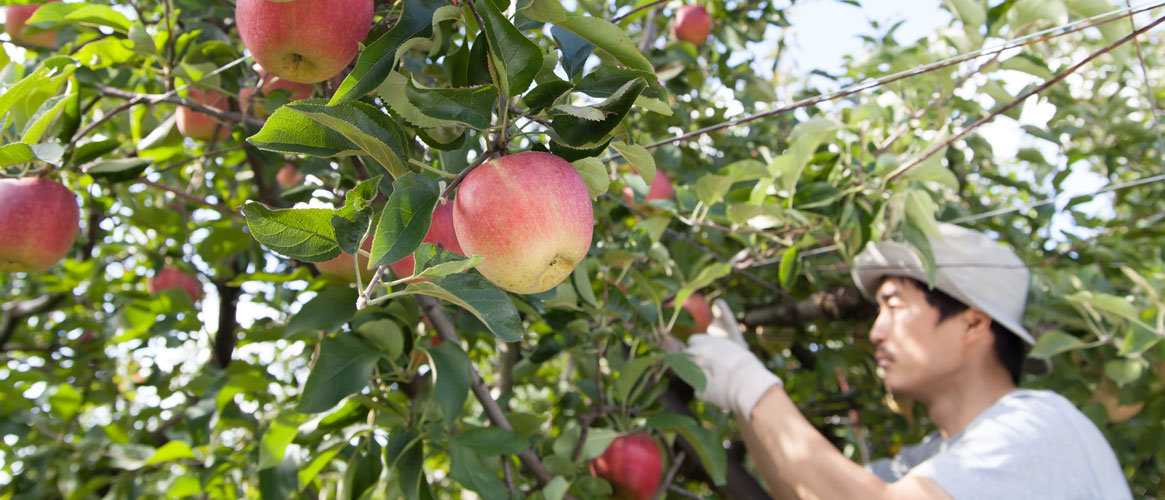Trellised, dwarf plantings in high-density orchards provide a great way to grow quality crops that can be trained, pruned, and harvested from the ground. However, these orchards require workers to pay attention to chemical safety, good body mechanics, moving equipment, outdoor conditions, and the proper use of cutting tools. It is important to know the characteristics of the orchard type you are working in, the safety conditions, along with the safe use of tools and equipment.
Trellised, dwarf, and high-density orchards share these characteristics
- Trees are planted between 5-to-10 feet of each other.
- The height is usually 8-to-10 feet.
- Permanent support systems encourage fast growth and hold up heavy crops.
- Supports can include pipes, wood posts, and/or high tensile wire.
- Low heights reduce the potential to contact power lines (but keep pipes and long-handled tools away from them).
- Ladders are not usually needed (but follow ladder safety policy when you use them).
General orchard safety requirements include
- Proper sanitation for hand washing and restrooms.
- Fresh drinking water. Don’t drink from irrigation systems—they may be contaminated.
- Terrain can be soft and uneven, so set up ladders carefully and watch your step.
- Properly lift by using your leg muscles, not your back.
- Practice good body mechanics by keeping your work close to your body to avoid strains and sprains.
- Wear your harvest container close to your body; don’t fill it too full.
Be aware of the field safety conditions in your orchards
- Watch for hazardous plants, animals, and insects.
- Cover exposed skin areas with coveralls, boots, and socks.
- Wear gloves, safety glasses, and a hat or helmet to protect you from splashing chemicals, dusts, and whipping branches.
- Make use of layered clothing to protect you from heat, cold, and wet conditions.
- Get training in heat illness signs, prevention, and procedures, including the provision of water, rest breaks, shade, first aid, and emergency response.
Many orchards use herbicides, pesticides, and growth-regulating hormones. Get training in the chemicals used at the orchard. Also make sure to consult chemical safety data sheets (SDS) so you know what type of personal protective equipment (PPE) to wear, which may include chemical-resistant suits, safety glasses, special gloves, boots, and respiratory protection.
Follow these steps for general chemical safety in the orchard
- Don’t eat fruit directly off the trees.
- Wash your hands before you eat, drink, smoke, or use the restroom.
- Change into clean clothing and take a shower before leaving work.
- Leave your boots at work or outside your home.
- Wash your work clothing separately from your family’s clothing.
- Always wear clean clothing at work.
Protect yourself from orchard pesticides
- Don’t enter or work in an orchard while it is being treated.
- You should never be sprayed or contacted with drifting overspray.
- Treated orchards should be posted, listed in your workplace, and/or your supervisor should tell you about them.
- Wait for the appropriate time period to pass before you enter a treated orchard.
- Know the decontamination procedures and have supplies available to wash your skin and eyes.
Orchards require a lot of pruning and cutting with hand and power tools
- Keep your tools sharp and well maintained.
- Properly adjust tools for your handgrip to minimize strains and reaching.
- Know where your hand is when you are cutting.
- Don’t cut branches bigger than your tools are designed to handle.
- Walk with tool-cutting edges toward the ground.
- Close blades and handsaws when not in use.
- Pneumatic tools reduce the force and repetition of your work. Get training in their use.
- Don’t remove guards or safety devices.
Use vehicle, tractor, equipment, and ATV safety procedures
- Watch for moving vehicles.
- Don’t sit under vehicles for shade.
- Walk around hitched equipment—not between the vehicle and the hitch.
- Tractors with rollover protective structures (ROPS) are safest, but not required in orchards where there isn’t enough vertical clearance. Don’t wear your seatbelt on a tractor without ROPS.
- Never ride on the tailgate of a truck or on trailers. Ride in vehicles with safety belts or drive to the site and walk in.
Orchards are busy, productive worksites. Follow these safety procedures to harvest your crops safely.
